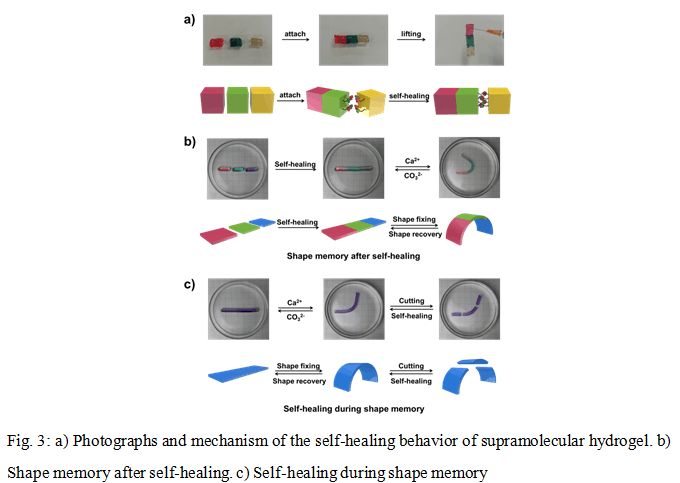Shape memory polymers (SMPs), which can recover from fixed temporary shapes to original shape under external stimuli, have wide potential applications in flexible electronics, biological medicine, and aerospace and so on. Most previous investigated shape memory polymers are thermo-responsive polymers, in which temporary shapes are fixed by vitrification or crystallization of switching domains, and the shape recovery is induced by heat. Considering the limitations of using heat as a trigger to recover the original shape in practical biomedical applications, new stimuli has to be explored to realize shape memory effect.
Because of the reversible and dynamic nature of supramolecular interactions, there is a great advantage of introducing them into SMPs. The Smart Polymer Group led by Prof. Tao Chen from Ningbo Institute of Materials Technology and Engineering, CAS, has successfully constructed self-healing shape memory hydrogels on the basis of supramolecular interactions (Chem. Commun. 2014, 50, 12277-12280).Moreover, they have achieved pH- and sugar-induced shape memory effect by the selection of a particular supramolecular interaction system (Macromol. Rapid Commun. 2015, 36, 533-537).However, SMPs on the basis of reversible supramolecular interactions still suffer from limitations such as poor mechanical strength and finite shape memory performance. Recently, they have prepared a novel mechanical stretchable supramolecular hydrogel with triple shape memory effect at macro/micro scale, which has been published in Chemical Science (Chem. Sci. 2016, DOI: 10.1039/C6SC02354A).

As shown in Fig. 1, acrylamide (AAm) was polymerized firstly in the presence of phenylboronic acid grafted alginate (Alg-PBA) and poly (vinyl alcohol) (PVA). After immersing in alkaline solution to generate reversible PBA-diol ester bonds, hydrogels with good mechanical performance due to the presence of double network structure is obtained. Trough adjust the ratio of two networks, a series of hydrogels with tunable mechanical strength can be obtained.
As the dynamic PBA-diol ester bonds are pH-responsive, they can be used as temporary crosslinks for shape fixing and realize the shape memory property. In addition, the chelation of alginate with Ca2+ can also endow the hydrogel shape memory effect. By combining these two non-interfering interactions, triple shape memory can be realized both at macroscale and microscale (Fig. 2).

Besides memorizing temporary shapes, dynamic PBA-diol ester bonds endow the hydrogel with self-healing property. Taking advantage of shape memory as well as self-healing capability, the as-prepared hydrogel retains shape memory ability after the self-healing process. And this idea help to understand the competence of the living creature and contributes to the creation of novel biomimic materials (Fig. 3).

This work was supported by the National Natural Science Foundation of China (21304105, 51303195), Zhejiang Nonprofit Technology Applied Research Program (2015c33031), and Excellent Youth Foundation of Zhejiang Province of China (LR14B040001).
Prof.Jiawei Zhang: zhangjiawei@nimte.ac.cn
Prof.Tao Chen: tao.chen@nimte.ac.cn
All Images by ![]()

